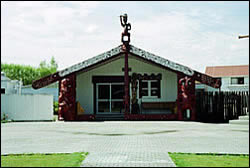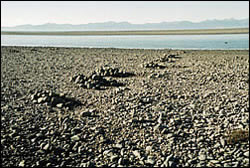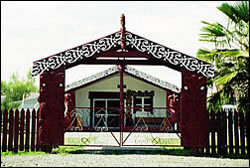Identifying Maori needs
Research Status: Past |
Te Awhina marae |
Introduction
Historically in Aotearoa-New Zealand there has been little or no involvement of tangata whenua in science and research projects. There have also been nationwide problems with the level of participation and capacity for Maori groups, such as iwi and hapu, to engage appropriately in resource management planning and policy, and to form effective relationships with local government, science, and other community groups. The ICM Motueka programme has developed strong links with tangata whenua in order to understand tangata whenua issues, values, knowledge systems, determine research priorities, identify with iwi and hapu their information needs and research questions, help build iwi and hapu research capability, to ultimately recognise and increase iwi/hapu participation in planning, policy, and decision-making. These steps, over many years, have been building blocks to determine desired sustainable resource management outcomes for the Motueka catchment, Maori aspirations for the Motueka catchment and other catchments, and set in place strategies and actions that move towards achieving the outcome. ICM approaches that have evolved during this journey have application to, and can help solve issues in other complex catchments.
Research Approach
Incorporating tangata whenua perspectives, values and knowledge requires the right process and effective dialogue to be established early on in ICM. The development of iwi/hapu-led and iwi/hapu-issue-driven collaborative projects has been instrumental in building strong iwi-science partnerships and increasing iwi/hapu engagement and interaction in ICM science objectives and inter-disciplinary research.
Engagement has been at many levels, including iwi participation at organised meetings and workshops, field-days, project planning, community reference groups, joint papers, sharing expertise and knowledge, and learning together. Representatives from iwi, hapu, Maori organisations have also attended and spoken at several ICM AGMs and science meetings, and accompanied scientists in the field. This spirit of cooperation and collaboration creates an environment in which we respect each other, learn, understand, and share different perspectives. It also improves access and uptake of both indigenous knowledge and science and technical information.
Establishing the right environment is therefore critical to ICM for increasing multi-stakeholder engagement, particularly iwi/hapu involvement. An integrated and inclusive understanding of stakeholder knowledge and values ultimately informs, guides, and improves decision-making to achieve the sustainable management of natural and cultural resources and the development of strategies to achieve desired stakeholder aspirations.
Research Results
We have documented a large amount of information on Mäori issues, key research themes, priorities, and needs, Maori values, knowledge systems, and subsequent collaborative projects that have been nurtured and implemented through the ICM process.
Commencing with an understanding of Mäori values and Mäori history for the Motueka catchment was essential for helping to understand tangata whenua issues, tangata whenua values, present day politics, governance, indigenous rights, and aspirations and contributed to a valuable Mäori knowledge base on the Motueka catchment and Te Tau Ihu region.
Mäori from local iwi, hapu, and marae groups became integral members of the ICM team from an early stage and greatly contributed to hui, research meetings, AGM's, field trips and discussion, research design, and the number of collaborative projects that eventuated. Some also became members of the Community Reference Group (CRG) very early in the ICM programme and have been an instrumental part of the ICM programme from the onset, helping to articulate and advance an essential cultural perspective and share their knowledge to other stakeholders and researchers. They are all acknowledged for this vital role and contribution.
Tools, techniques and lessons
What we have learnt from working with indigenous groups in the Motueka catchment can be applied nationally and internationally. Four main priority research areas evolved from the collaborative indigenous research in the ICM research programme:
- Methods and tools for effective social process and collaborative learning
- Development of iwi information and knowledge systems
Development of iwi cultural indicators for assessing the natural environment and Māori well-being - Modelling and futures planning.
The many ICM approaches and techniques we have learnt with indigenous groups and other stakeholders can be applied to many other areas and issues at various scales and include:
- Stakeholder analysis and networking maps
- Issue identification and analysis
- Understanding cultural values and perspectives
- Developing best practice and participatory research techniques
- Improving the responsiveness of science and research to Māori needs and issues
- Helping establish collaborative projects and partnerships that make a difference
- Building capacity for undertaking and engaging in science and research
- Expanding knowledge and understanding (e.g. integrated knowledge systems)
- Improving inputs into planning and policy
- Improving capabilities for decision making.
Collaborative projects
There are many outputs (e.g., hui, workshops, AGM, reports, papers, collaborative projects) that have been completed as part of our collaborative work with Maori groups in Te Tau Ihu, including iwi and hapu. However, it is the establishment and maintenance of the on-going relationship with the "people of the land" that has been most important.
To understand the nature of the significance various Maori groups play in the region and nationally it is essential to understand the historical context of tangata whenua to provide the basis for all other ICM work.
- Maori migration and occupation into the northern South Island and Motueka catchment
- Maori values and history
- Maori present day
 |
 |
Mouth of Motueka River |
Te Awhina marae |
Recent Publications
Recent Presentations
BMPs, BEPs and Guidelines
| Title | Description |
| Good Practice Guidelines for Working with Tangata Whenua and Māori Organisations: Consolidating our learning | These good practice guidelines are based on just over a decade of learning by central and local gove...More » |
| Kawe Korero: Guidelines for communicating with Maori |
From guide: These Guidelines for Communicating with Mäori have been developed to assist staff ...More » |
| Kaitiakitanga and Local Government: Tangata Whenua participation in environmental management | A practical guide for incorporating the values of tangata Whenua into the decision making process co...More » |
| Assessment of Environmental Effects. Chapter 11: Consultation Approaches |
From website: THe consulative programme was developed to canvas particular matters of interest...More » |
| Maori and the Resource Management Act |
Edited from guide: A guide on incorporating Maori involvement in the management of natural and...More » |
| Guidelines for Consulting with Tangata Whenua under the RMA: An Update on Case Law |
From website: This publication provides guidance on how to undertake consultation with tangata...More » |
| Guidelines for Research and Evaluation with Mäori |
From guide: The guidelines outlined in this document are designed to assist staff from the Cen...More » |
| Mäori Liaison Guidelines | Guidelines for working with Tangata Whenua. ...More » |
Primary Contacts:

|
Garth Harmsworth
Email More details» |
Institute Landcare Research |
Expertise environmental planning, Maori research, Maori issues, land resource assessment, GIS applications. |